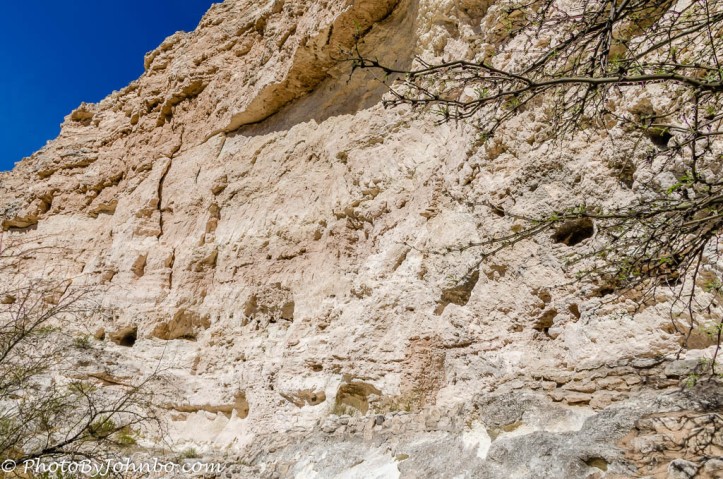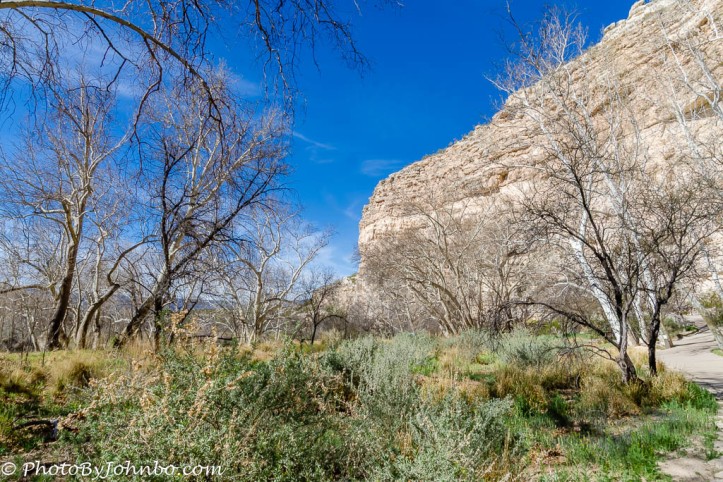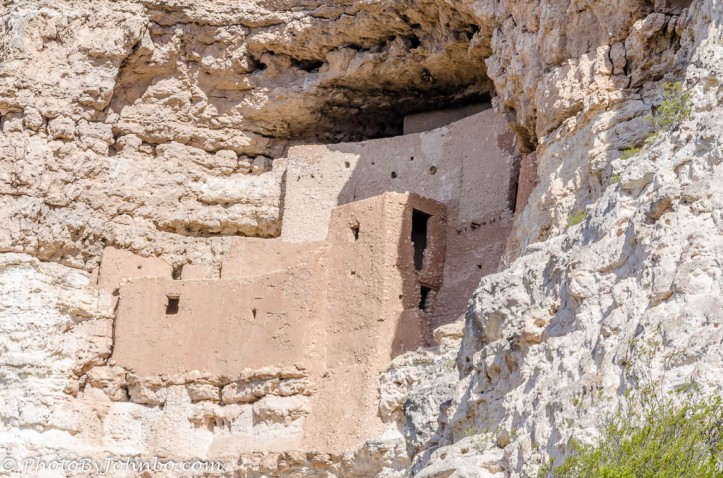Last week, we visited Tuzigoot, a native American pueblo. Just a few miles southeast of Tuzigoot, a short distance from Exit 289 on I-17 south of Flagstaff, intriguing signs point to an attraction called Montezuma’s Castle. A pueblo built by the Sinagua people is located in a riparian area. The desert in this area is punctuated by the lush, green area appropriately known as Verde Valley (verde is the Spanish word for “green.”) It’s no wonder the Sinagua picked this location to build their rock dwellings. The “castle” is a 20-plus room “high rise” apartment structure. The name given the pueblo is a misnomer and the Sinagua people have no cultural or ancestral relationship with the Aztecs or Emperor Montezuma. Literally, Sinagua translates to the Spanish “Without water”, as the desert people survived quite nicely, though life for those living in the vicinity of Beaver Creek had plenty of water from the perennial springs that feed the riparian area.
 Though it’s hard to tell by this photograph, the openings in the cliff lead to a large complex of living spaces for the Sinagua. In 1906, President Roosevelt named the site one of our first National Monuments. Early visitors to the monument were allowed to climb a series of ladders to actually visit the interior of the ruins. Due to damage caused by the tourists, access to the interior was prohibited in the early 1950s.
Though it’s hard to tell by this photograph, the openings in the cliff lead to a large complex of living spaces for the Sinagua. In 1906, President Roosevelt named the site one of our first National Monuments. Early visitors to the monument were allowed to climb a series of ladders to actually visit the interior of the ruins. Due to damage caused by the tourists, access to the interior was prohibited in the early 1950s.
 The large limestone wall hides all but the most visible portion of the pueblo, as seen in the opening photo. Over 350,000 visitors a year stop to wander the concrete walkway and look at the pueblo, unfortunately only from the base of the limestone cliff. The white giant trees in the area are not desert trees, they are giant sycamores. The photos were taken in March so the deciduous trees haven’t yet started to put on their spring greenery. The gallery of images below include images of the dwellings and the nearby area. Next week we look at Montezuma’s Well, an interesting deep water “lake” that is perennially fed by underground water stores. Click on an image below to enlarge it and to scroll through the gallery.
The large limestone wall hides all but the most visible portion of the pueblo, as seen in the opening photo. Over 350,000 visitors a year stop to wander the concrete walkway and look at the pueblo, unfortunately only from the base of the limestone cliff. The white giant trees in the area are not desert trees, they are giant sycamores. The photos were taken in March so the deciduous trees haven’t yet started to put on their spring greenery. The gallery of images below include images of the dwellings and the nearby area. Next week we look at Montezuma’s Well, an interesting deep water “lake” that is perennially fed by underground water stores. Click on an image below to enlarge it and to scroll through the gallery.
John Steiner













Hidden castle……. nice one!
Cool! I had no idea there were ruins (or whatever the correct word is) like these in the States! Great pics.
Wonderful ! thank you for sharing!
These are just wonderful shots! I think I went to this place once way back in the 60’s.